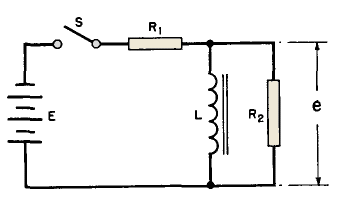| Electronic Transformers and Circuits is a free introductory textbook on transformers and related circuits. See the editorial for more information.... |

|

Home  Pulse and Video Transformers Pulse and Video Transformers  Response at the Top of the Pulse Response at the Top of the Pulse |
||||||






|
||||||
Response at the Top of the Pulse
Here the inductance L is the OCL of the transformer, and R1 and R2 remain the same as before. Since the rate of voltage change is relatively small during this period, capacitances C1 and C2 disappear. Also, since leakage inductance usually is small compared with the OCL, it is neglected. At the beginning of the pulse, the voltage e across R2 is assumed to be at steady value Ea which is true if the voltage rise is rapid. Curves for the top of the wave are shown by Fig. 234.
Several curves are given; they represent several types of pulse amplifiers ranging from a pentode in which R2 is one-tenth of R1 to an amplifier in which load resistance is infinite and output power is zero. In the latter curve, the voltage e has for its initial value the voltage of the source. All the curves are exponential, having a common point at 0, 1. Abscissas are the product of time τ and R1/Le, time τ being the duration of the pulse between points a and b in Fig. 226. The greater the inductance Le the less the deviation from constant voltage during the pulse.
|
||||||
Home  Pulse and Video Transformers Pulse and Video Transformers  Response at the Top of the Pulse Response at the Top of the Pulse |
||||||
Last Update: 2011-01-24



